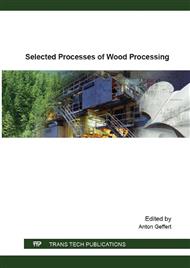p.3
p.10
p.17
p.25
p.31
p.38
p.44
p.50
The Influence of the Long-Term Storage of Hardwood on the Selected Physical and Mechanical Properties in View of Pulping
Abstract:
Wood is loosely stored to ensure continuous production inside paper mills where it is exposed to the effect of external factors. The impact of storage leads to some changes of mechanical and physical properties of wood, but these changes are not the same in all specimens. In this paper, it has been observed that the long term storage of wood influences the impact strength in bending and the permeability of wood for fluids. During the storage, there was a decrease of impact strength in bending of poplar heartwood by 28.3% and oak by 22.1% and mature beech wood by 37.3%. Also, there was decreased a permeability of wood, poplar sapwood 18.3 % and heartwood of 53.9%; oak sapwood by 20.0% and heartwood by 20.3%; beech sapwood 45.8% and mature wood by 48.2%. By decrease of the observed properties of the stored wood, a deterioration a quality of produced pulp can be expected (a higher Kappa number, amount reject and decrease the mechanical properties of pulp).
Info:
Periodical:
Pages:
10-16
Citation:
Online since:
April 2016
Authors:
Price:
Сopyright:
© 2016 Trans Tech Publications Ltd. All Rights Reserved
Share:
Citation:


